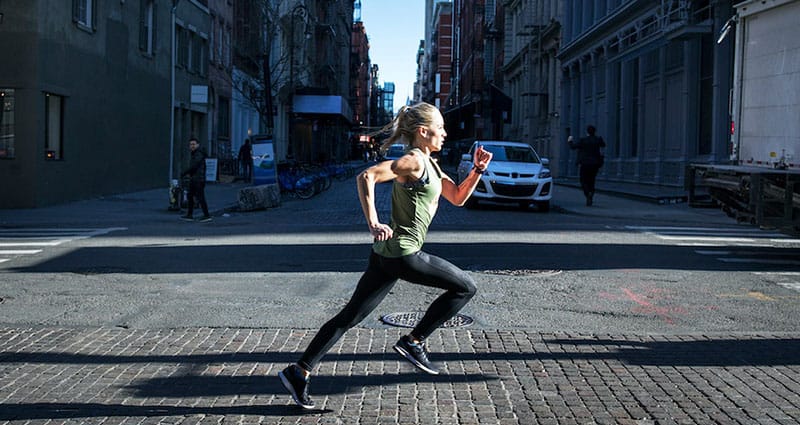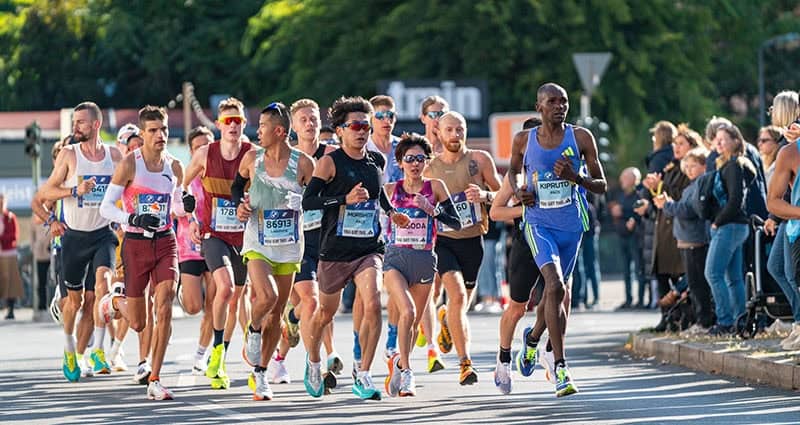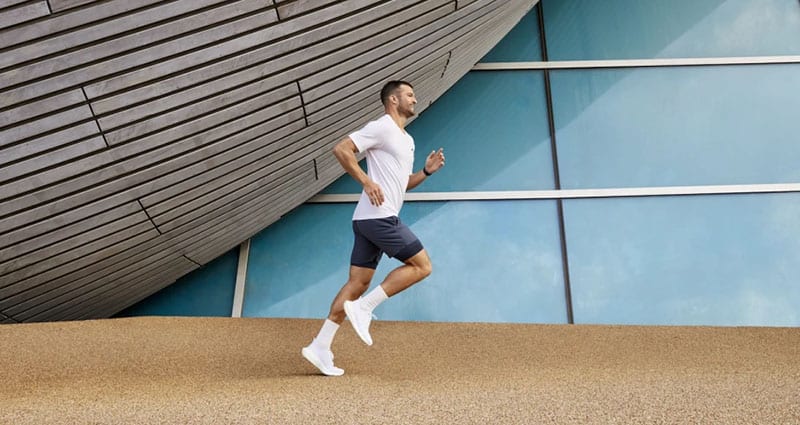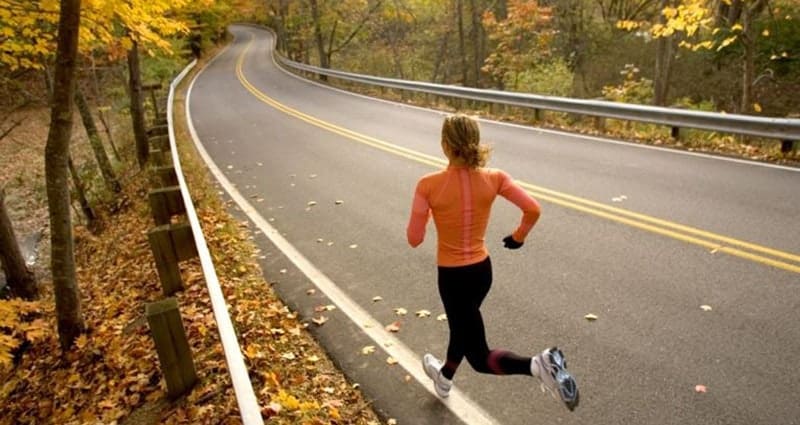Running stride length is the visible feature that separates front-pack runners from the slower ones. A seemingly effortless, powerful stride is graceful and drives speed more than cadence.
“Stride length drives speed more than cadence.”
In fact, your cadence is similar to that of Olympian Mo Farah. It is his average stride length of around 2 meters that is in another league. If you have ever witnessed elite East African athletes running past you on a U-turn, then you know what I’m talking about.
Stride Length and Cadence
From a biomechanical point of view, only two factors lead to faster running—stride length and cadence.
First, let’s have a quick look at cadence, which is synonymous with stride frequency. The optimal cadence is generally considered to be around 180 strides per minute (spm). Although average runners only have a cadence of 150 – 170 spm, this doesn’t explain the difference in running pace compared to elite runners. Mo Farah is known for a notoriously low stride rate, after all.
The critical thing about cadence is that there’s much individual variation. So don’t force yourself into a stride that feels unnatural to you. An optimal stride is largely self-selected by your nervous system and, to a lesser extent, by your conscious effort. Only the optimal ground contact time (GCT) leads to an ideal energy return by taking advantage of the free elastic energy stored during the stance phase. As your neuromuscular coordination improves, your GCT will be lower.
That doesn’t mean you shouldn’t take control of your cadence. Some running watches feature a metronome that helps dictate your leg turnover. Aim for small changes in strides per minute rather than big ones.
By now, it should be obvious that running stride length is what separates the elites from us mere mortals. A sub-30 minute 10K time requires a stride length of around 2 meters. A mid-pack runner at a local event only covers half as much ground per stride. The good news is you can improve stride length—by a lot. The bad news: It’s not a quick fix.
Avoid Overstriding
A powerful and efficient stride does not require striking the ground ahead of your body. This only breaks your momentum and places unnecessary stress on your knees. This pattern is typical in heel strikers and is the leading cause of shin splints. In short, it’s inefficient and a significant cause of injuries.
The action is behind your body and not in front of it. That means a powerful stride begins under your center of gravity, right under your hips. Admittedly, that’s easier said than done, as most of us are guilty of sitting for hours in an office daily. That shortens the hip flexors and compromises good running form.
To counter this, stretch your hip flexors briefly after the warm-up and once again for an extended time after your workout. You can also reach high with your hands, like occasionally plucking an apple during your run. You’ll notice your hips coming forward. Try to maintain that position. If your hips are properly aligned, you’ll recruit the gluteus maximus—your body’s largest muscle, as the name gives away. Yes, if you want stride power, you have to use all the running muscles, and proper running form allows you to do that.
Once your hips are aligned, you’ll be less likely to overstride. A good cue that can help is to ‘put your foot down earlier.’ This may initially shorten your running stride length and up the cadence. But since you ‘release the brakes’, engage your glutes, and utilize more elastic energy, you will still be faster.
Stride Length & VO2max
Before we discuss how to train your muscles for a more powerful stride, let me explain the interplay between running stride length and VO2 max.
If you were a sprinter, a powerful stride paired with a flawless technique would be all it took to excel. But you are a distance runner. You have to supply oxygen at a fast rate so that your muscles can burn glycogen to fuel the effort for a prolonged period of time. There are more factors, of course, such as fatigue resistance at race pace, lactate threshold, and running economy. Yet maximal aerobic capacity amounts to 70 – 80 percent of your running performance.
But I will also argue that your stride power limits your VO2 max. If you lined up the competitors of a local 10K race and then rearranged that line based on their 100m sprint performance, the 2 lines would look strikingly similar. Thus, if you were to test your VO2 max on a treadmill in a laboratory, you’d most likely be limited by your neuromuscular power before you can even access your maximal aerobic capacity.
In other words, your general speed—and therefore a powerful stride—is a precondition for effective VO2 max interval training.
Essential Strength Training
We often associate strength training with sprinters. But running, in general, is a power sport. Think of it as long series of jumps.
Strength is the foundation for that power. In case you aren’t familiar with the science jargon, strength produces force over time, and power produces force fast. We are after the latter. But just as you wouldn’t excel at lactate threshold training without a solid aerobic base of easy running mileage, you wouldn’t improve your power without a base of strength.
Communicating with my athletes, there seems to be a lot of confusion about strength training sets and repetitions. We runners typically have a strong work ethic and, therefore, a ‘more is better’ attitude. Yet, I will argue that quality trumps quantity. Heavy one-set exercises in the 6 – 8 repetition range, twice a week, develop the necessary neuromuscular strength for a powerful stride. You don’t need to train your muscles for endurance in the gym. That’s what running is for.
In regards to exercise selection, aim for compound movements. You are not a bodybuilder isolating muscle groups for maximal growth so that you can take selfies in the bathroom. You’re after new PRs, which call for functional muscles. Then, progress everything from general to running-specific. For example, build strength with squats and deadlifts first and then introduce single-leg exercises that more closely resemble running, such as weighted forward lunges.
I will elaborate more on strength training in a future article.
The Magic of Plyometrics
If you are over 40, skip to the next section, where I cover hill sprints and flat sprints. For older runners, the potential risk of injury from plyometric exercises outweighs the benefits. Sprints should be your only plyometric training.
Plyometrics can be an effective way of developing stride power for everyone under the age of 40. However, I don’t recommend it for beginner runners unless you consider yourself an athlete in another weight-bearing sport. A foundation of strength is crucial for plyometric training.
The main benefit of plyometric exercises is an improvement of the so-called stretch-shortening cycle (SSC). It is a pre-stretch of a muscle that allows rapid force production, as needed in jumping and running. It happens when a concentric muscle action immediately follows an eccentric muscle action. Try jumping as high as possible from any static position and then again by quickly bending your knees before rebounding into a jump. That’s the power of the SSC in action.
Jump squats, burpees, jumping lunges, side-hops, and box jumps are just a few examples of plyometric exercises you can add to your running program. The best time to perform them is after a thorough warm-up, including a few running drills. That is, before your main set of running. If you haven’t done plyometrics before, phase them in slowly and limit them to twice a week.
Hill Sprints vs Flat Sprints
A sprint is the most specific plyometric training a runner can do. Sprints are synonymous with strides, only that strides are typically not all-out efforts. As an endurance runner, that’s anywhere from 1500m race pace down to 400m race pace. You don’t need to go faster than that to reap the benefits. During all-out sprinting, we tend to tense up. We aim to stride powerful but relaxed.
Like your endurance base, general speed is fundamental and should never be entirely phased out during any training cycle. However, I recommend adding an element of progression. For that reason, my training plans use hills sprints right from the beginning. Hill sprints recruit more muscle fibers than sprints on flat terrain and with a lower landing force.
The disadvantage of hill sprints is a lower leg turnover. So, closer to your race, you should transition to sprints on the flat, ideally on a running track. That way, your neuromuscular system gets primed for speed, a precondition for faster training paces like VO2 max intervals. Nevertheless, it’s a good idea to maintain your strength with hill sprints once or every other week.
As endurance runners, we don’t need dedicated sprint sessions. As little as 3 repetitions twice a week during or after easy runs will do. If you’re an advanced runner, you can slowly build up to about 10 repetitions. It’s wise to start your first sprint conservatively and then increase the pace over the following repetitions. I also recommend a flying start and a gradual acceleration to reduce the risk of injury.
We have covered a lot of ground here regarding running stride length. The key takeaway is that a multifaceted approach is necessary to really make a difference. Running may be a simple sport, but that doesn’t mean running training can be simplistic.
Are you stagnating despite hard training? You are not alone. Pushing harder is common, but it rarely is the correct answer. In most cases, the problem is a mishmash of random workouts, which typically leads to subpar performances on race day – or worse – burnout and debilitating injuries.
But it doesn’t have to be that way. You can take the guesswork out of training with an expertly designed training plan or flexible and individualized 1-on-1 online coaching. Professional guidance saves time, makes training more enjoyable, and gives you a fair chance to set new personal records.





